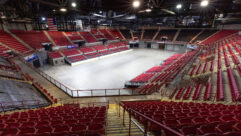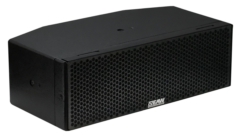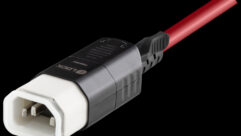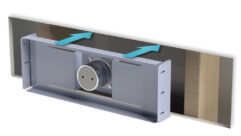
The Buzz: Install of the Month:
Copps Coliseum, Hamilton, Ontario
Jun 1, 2006 12:00 PM,
By Trevor Boyer
Out of the Penalty Box
Forty-four TOA HX-5B speakers are rigged from trusses around Copps Coliseum, home of the AHL’s Hamilton Bulldogs.
At Copps Coliseum in Hamilton, Ontario, hockey fans were getting frustrated. The American Hockey League’s Hamilton Bulldogs, who play their home games at Copps and own the building’s sound system, were getting complaints that the previous PA system rendered the game announcers unintelligible. The music didn’t sound much better.
In place was a “really old, antiquated system, with some horn tweeters up there,” according to Rob Tiller, sales representative with FFP Laser Systems in Mississauga, Ontario.
FFP Laser Systems acted as the liaison between Copps Coliseum and the eventual equipment suppliers. The company hosted a demo at the arena, and out of three manufacturers, it chose TOA Electronics for the quality of the sound the manufacturer produced in Copps, which has a capacity of 20,000.
The Bulldogs, a minor-league farm team for the NHL’s Montreal Canadiens, were working with a pretty tight budget. Moreover, because the Bulldogs share the arena with touring attractions such as the Ice Capades that bring in their own gear, sound equipment couldn’t be dead-hung in Copps. It needed to be mounted on trusses so that it could be flown up to the ceiling. That created extra costs in terms of rigging and labor.
So working with a budget of about $50,000 Canadian, TOA designed a system that would cover the lower bowl of the arena and could be expanded to cover the upper bowl in the future. (Counting the labor and rigging involved, the cost of the entire installation was closer to $100,000 Canadian, and the Bulldogs received a discount from TOA.) Paul Rennick, an audio technician at TOA, designed the system on site.
“Our biggest challenge wasn’t really the cost,” says Tiller. “It was more the rigging issues within the building. The building was concerned with sight lines and the ability to move equipment in and out.”
Copps was very specific about where FFP Laser could place the rig, and in the end the company installed four 25ft. trusses, one on each side of the ice. Each truss was rigged with a one-ton motor. Bunning Splicing & Rigging was tapped as the rigging supplier, and Nedco for power equipment.
TOA supplied all audio equipment, including speakers, subwoofers, amplifiers, and a D901 digital mixer with internal DSP. Rennick of TOA designed the system so that the east and west trusses (behind either goal) each have four pairs of HX-5B variable-angle speakers, and the north and south (center ice) each have six pairs. Around the score clock above the ice is a permanent truss, where four cabinets were rigged — that’s a total of 44 HX-5B speakers around Copps. (The score clock speakers deliver announcements to players on the ice.) Rennick says that the biggest challenge in designing the system was dealing with the speakers’ 100-degree dispersion pattern — he had to ensure that their lines didn’t cross.
Copps Coliseum also uses 19 IP-600D dual-channel 600W/channel amplifiers and 12 F-120B subwoofers from TOA Electronics.
The TOA D901 mixer is a 12-input, eight-output digital mixer that allows full DSP on all channels. Rennick did the DSP for the system within the D901. As the system is used not just by the Bulldogs but is also rented out, he created presets designed to suit outside operators who run the system.
TOA also supplied a D-911 remote controller for the mixer, which is key for the person running the D901. That’s because he’s typically also doing sound effects from a computer source, which introduces different levels from different files. The remote allows him to adjust levels while he’s at the computer. The main source of music is a Tascam two-channel CD player.
Microphones are another important audio source for the arena. TOA supplied a total of eight wireless microphones, both WM-4210 handheld and WM-4310 lavalier models. The system employs WTU-4800 wireless receivers and YW-4500 UHF fixed-mount dipole antennas. There’s also a wired mic in the scorekeeper’s box.
Tiller says that there’s a nice, even sound everywhere in the bowl of the arena, though in the corners there’s a bit of a drop-off. “We knew from the start that they were going to stretch the system,” he says. “At the end of the day we were 100 percent pleased with what TOA delivered. It’s miles above what was there before.”
Subscribe to Sound & Video Contractor e-newsletters!
Sound & Video Contractor EXTRA
Systems Integration Special Focus series:
Houses of Worship
Corporate AV
Breaking industry news in your email inbox every other week! Subscribe at www.svconline.com.










